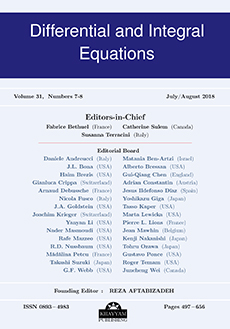Abstract
Let $\Omega$ be a smooth bounded domain in $\mathbb R^2$. For $\varepsilon>0$ small, we construct non-constant solutions to the Ginzburg-Landau equations $$ -\Delta u=\frac{1}{\varepsilon^2}(1-|u|^2)u \ \text{ in $\Omega$} $$ such that on $\partial \Omega$ u satisfies $|u|=1$ and $u\wedge \partial_\nu u=0$. These boundary conditions are called semi-stiff and are intermediate between the Dirichlet and the homogeneous Neumann boundary conditions. In order to construct such solutions, we use a variational reduction method very similar to the one used in [12]. We obtain the exact same result as the authors of the aforementioned article obtained for the Neumann problem. This is because the renormalized energy for the Neumann problem and for the semi-stiff problem are the same. In particular, if $\Omega$ is simply connected a solution with degree one on the boundary always exists and if $\Omega$ is not simply connected, then for any $k\geq 1$ a solution with $k$ vortices of degree one exists.
Citation
Rémy Rodiac. "Variational reduction for semi-stiff Ginzburg-Landau vortices." Differential Integral Equations 32 (9/10) 541 - 582, September/October 2019. https://doi.org/10.57262/die/1565661621





